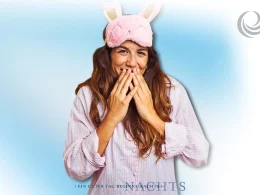It sounds almost magical: you are lying half asleep, just before finally drifting off to sleep.Suddenly, new ideas, creative approaches or solutions to problems that previously seemed unattainable appear in your head. This fine line between being awake and asleep – often referred to as hypnagogia – is a state in which thoughts wander freely and the brain functions in a way that is very different from everyday waking consciousness. But what exactly is hypnagogia?
Are there reasons for the increased creativity during half-sleep and can this be utilised effectively? You can find out all this and much more in this article.
What is hypnagogia?
Hypnagogia is the transitional state between wakefulness and sleep, in which consciousness slowly drifts off but is not yet completely switched off. During this phase, the brain often experiences fleeting, dream-like images, thoughts and sensory impressions that cannot usually be consciously controlled. Hypnagogia usually occurs when falling asleep and is known for spontaneous creativity and unusual associations. It differs from normal dreams as it can be accompanied by real impressions, which makes this state interesting as a creative and meditative intermediate phase.
Why are we more creative when we are half asleep?
In the state between wakefulness and sleep, our brain goes through a unique phase in which thoughts, associations and impressions seem to occur at random and a particularly large number of new ideas can arise. This happens because the prefrontal cortex – the area responsible for logical thinking and decision-making – no longer has full control over our thoughts. This role is taken over by other areas of the brain that are active in unconscious processes.
During hypnagogia, the brain processes impressions and memories differently than in the waking state, often in a way that lets go of logical connections and creates space for new ideas and solutions. It is as if the brain is working in a kind of creative idle phase in which thoughts and associations can arise without structure or strict logic. The painter Salvador Dalí, the inventor Thomas Edison and the physicist Albert Einstein consciously utilised this phase by taking short naps and waking up as soon as they fell into a deep sleep. In this way, they hoped to capture the flashes of inspiration they experienced during half-sleep before consciousness could take control again.
Can you consciously utilise the creative state of half-sleep?
Can you consciously utilise the creative state of half-sleep?
There are several techniques that can be used to consciously induce and utilise the creative phase just before falling asleep:
- the Dalí method: The surrealist painter Salvador Dalí would often lie down on an armchair with a heavy object, such as a key, in his hand and slowly let himself drift off into half-sleep. As soon as he actually fell asleep and his muscles relaxed, the object fell to the floor and the sound woke him up. This enabled him to consciously retain the creative ideas and visualisations from this hypnagogic phase.
- power napping for more creativity: Even today, many people use short naps of max. 20 minutes to specifically induce this particular creative state. While a longer nap leads the brain into deeper sleep phases, a short power nap can help to achieve hypnagogia without falling into deep sleep. You can read more about the power nap in this article – here.
- relaxation techniques before falling asleep: Meditative exercises or relaxing visualisations – such as resting images – before falling asleep can support the entry into hypnagogia. You consciously let your mind wander without paying attention to logical sequences or meaning. The aim is to gently drift off into a kind of dreamy state without actually falling asleep. This can lead to creative thoughts or deep relaxation, resulting in very similar effects. On our blog you will find the article Fall asleep better with relaxation exercises practical tips and hints for optimal relaxation.
What happens in the brain during hypnagogia?
Various regions of the brain are particularly active during hypnagogia. These networks – also known as the default mode network – are also involved in daydreams and spontaneous thought activities and promote a kind of playful, unstructured creativity. Researchers suspect that during this phase, memory and previously learnt information are linked in new ways.
Some scientists compare hypnagogia with states that people experience in the REM sleep phase. In this sleep phase, in which we dream a lot, there is a multitude of sensory impressions and free associations. The big difference between half-sleep and the REM phase is that in the state of half-sleep, i.e. shortly before falling asleep, we still have access to these ideas and could theoretically consciously retain them.
What are the benefits of hypnagogy?
There is ample evidence that creative problem solving and unusual associations are best generated when the mind is not distracted by everyday tasks. In semi-sleep mode, thoughts can unfold freely without being hindered by conscious control mechanisms. Research suggests that it is precisely in this state that solutions to deadlocked problems emerge, new ideas take shape and people come up with inspiring ideas that they would not have thought of when awake.
Various studies from the USA and France, for example, have shown that people who briefly immersed themselves in hypnagogia were able to recognise complex patterns more quickly and solve creative tasks better than those who did not enter this state. Consciously utilising this phase can be a valuable strategy, especially for people who have to work creatively on a regular basis – such as artists, designers or scientists.
How can creativity during half-sleep be utilised in everyday life?
There are several ways to effectively utilise the creative phase just before falling asleep in everyday life. For example, short creative breaks can be beneficial. Instead of constantly concentrating while working, it is better to plan time-limited relaxation phases. These promote access to hypnagogic ideas and give our brain a break from constant activity.
It can also be worth keeping a notebook to hand – on the bedside table, for example. This way, creative ideas and flashes of inspiration can be written down immediately while you are half asleep. Alternatively, you can also use the voice recorder on your mobile phone or a dictaphone to capture spontaneous ideas without having to switch on the light.
Last but not least, we recommend trying out the techniques mentioned above, such as the Dalí method or power napping, to consciously induce the state of hypnagogia. Regular meditation can also facilitate the transition to creative half-sleep and free our brain from rigid thought structures.
Try it for yourself! Make yourself comfortable in an armchair, preferably with our billerbeck neck pillow, let your mind wander and achieve complete relaxation. We can’t wait to see what creative ideas you come up with this way.














